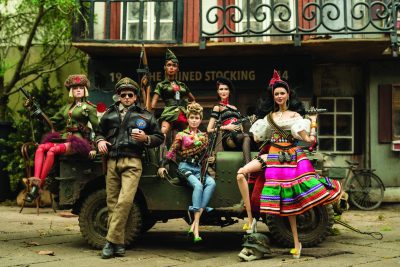
Welcome to Marwen – The dolls of Marwen (from left): Anna (Gwendoline Christie), Cap’n Hogie (Steve Carell), GI Julie (Janelle Monáe), Roberta (Merritt Wever), Suzette (Leslie Zemeckis) and Carlala (Eiza Gonzalez) – Photo courtesy of Universal Pictures.
Welcome to Marwen is the fictionalized story of how artist Mark Hogancamp survived a near fatal beating and, despite losing all his memories from before the beating, overcame that trauma and being in a coma for weeks, and came to be a well-regarded artist in a different field.
This is not just the story of one man overcoming overwhelming odds to survive, but to flourish.
Welcome to Marwen opens with a WWII pilot being shot down and seeking refuge in a Belgian village – but as the sequence proceeds, things shift from relatively real to completely surreal as we discover that we’re actually watching a story play out in the backyard of a mobile home.
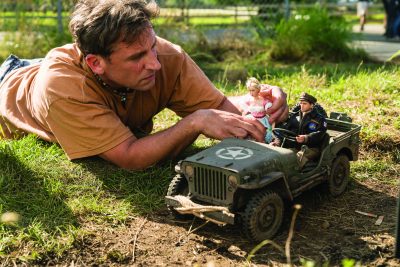
Welcome to Marwen – Mark Hogancamp (Steve Carell) photographs the dolls for his fictional town – Photo courtesy of Universal Pictures.
Mark Hogancamp (Steve Carell, Battle of the Sexes, The Big Short) is photographing repurposed dolls and action figures to tell the story of Cap’n Hogie – clearly a surrogate figure for himself.
Hogancamp has constructed a Belgian village – which he calls Marwen – in his yard as a means of dealing with the trauma he doesn’t remember and the loss of his memories.
He was beaten to within an inch of his life for mentioning to a group of guys in the local bar that he occasionally liked to wear women’s shoes.
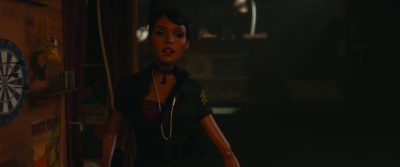
Welcome to Marwen – GI Julie – Photo courtesy of Universal Pictures.
His recovery is aided by his physiotherapist, Julie (Janelle Monáe, Hidden Figures, Electric Dreams), a Russian caregiver, Anna (Gwendoline Christie, Game of Thrones), hobby shop employee Roberta (Merritt Wever, The Walking Dead, Godless) and, later in the film, Leslie Mann’s (This is 40, Blockers) Nicol (Nicole without the ‘e’).
Written Caroline Thompson (Nightmare Before Christmas, Corpse Bride) and director Robert Zemeckis (Back to the Future, The Walk), Welcome to Marwen is not your standard feel good movie.
Cleverly constructed in such a way that we learn about Hogancamp’s ordeal as his memory of the event returns – gradually – through his Marwen stories and photographs.
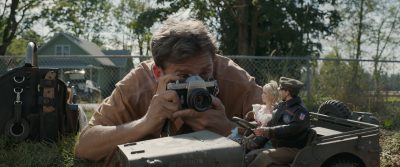
Welcome to Marwen – Mark Hogancamp (Steve Carell) photographs the dolls for his fictional town – Photo courtesy of Universal Pictures.
Zemeckis keeps us off balance by making the transition from real to imaginary (and back) gradual – and blending the two is unique ways.
We learn a bit about the women in Hogancamp’s life through a combination of their behavior in his Marwen stories and through glimpses of their lives as he interacts with them (Nicol has suffered a different but probably equally painful tragedy that we only learn about through careful placement of a photo, for example).
Hogancamp is – at times – abusive of his medications (taking too many, or throwing them out) and, at times, thinks the beating must somehow have been his fault.
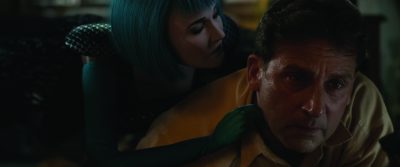
Welcome to Marwen – Deja Thoris (Diane Kruger) and Mark Hogancamp (Steve Carell) – Photo courtesy of Universal Pictures.
Through his Marwen adventures – and the presence of figure he calls Deja Thoris (voiced by Diane Kruger) – he is working out his issues, but Deja (whom he must have somehow remembered from reading Edgar Rice Burroughs’ John Carter of Mars books) proves to be a major stumbling block (he can’t recall how she came to be part of the story).
The Marwen setting, WWII, also seems like an obstructed memory coming to life – the undying Nazis mirror the five goons who beat him.
Welcome to Marwen neither paints Hogancamp as a saint (which would be boring) or a loser who becomes something better as a result of his recovery (which would also be boring and a cliché).
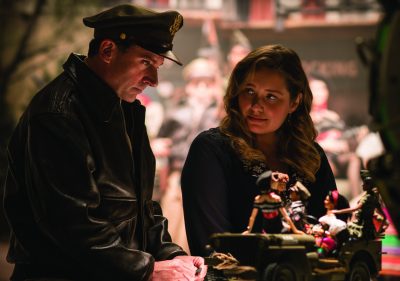
Welcome to Marwen – Mark Hogancamp (Steve Carell) and Roberta (Merritt Wever) with the dolls of Mark’s fictional town – Photo courtesy of Universal Pictures.
He’s just a talented guy with a slight deviation from what some people call ‘the norm’ (and exactly what is normal, anyway?).
That he develops a different talent as he recovers isn’t a miracle so much as it’s a necessity that enables him to deal – and, ultimately, face his assailants in court.
The two women in his life that influence him most do so for very different reasons. That he is oblivious to one and mistakes the intention of the other makes him even more human – more relatable.
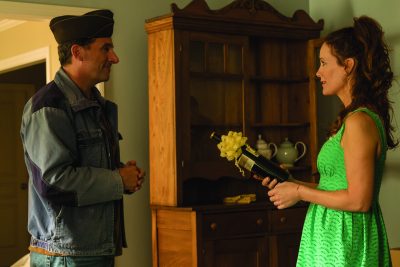
Welcome to Marwen – Mark Hogancamp (Steve Carell) and Nicol (Leslie Mann) – Photo courtesy of Universal Pictures.
Before the credits roll, we get to see the real Hogancamp (and the real Cap’n Hogie) and learn some cool stuff about how his life and art have grown on.
Mention should also be made of Conrad Coates who, in a very amount of screen time, makes Hogancamp’s lawyer, Demaryius Johnson, a warm and relatable figure.
Welcome to Marwen is one of the year’s best films.
Final Grade: A+